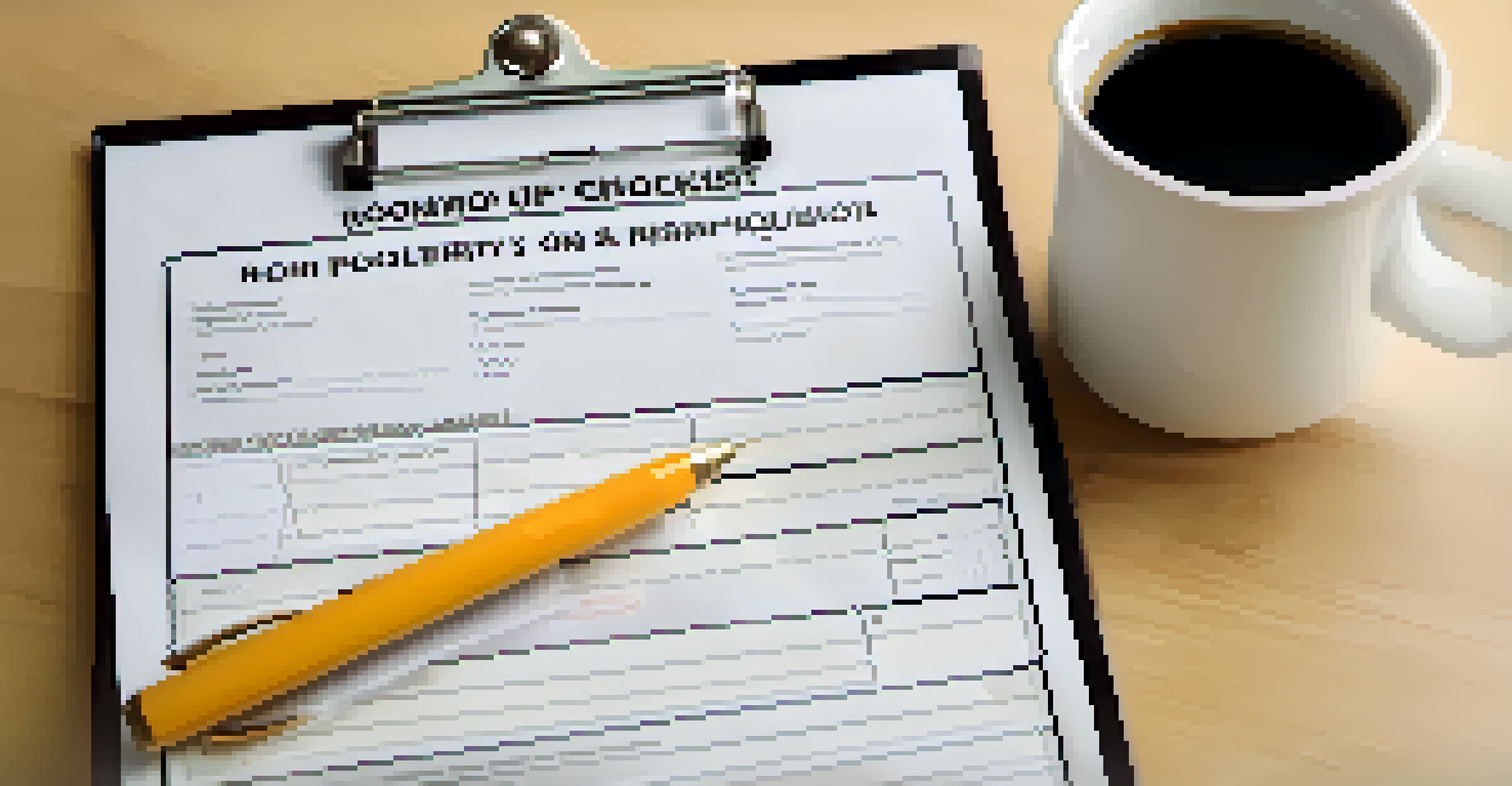How to Conduct Successful Tenant Move-Out Inspections

Understanding the Importance of Move-Out Inspections
Tenant move-out inspections are crucial for both landlords and tenants. They help ensure that the property is returned in good condition and that any damages are documented. This process not only protects the landlord’s investment but also provides tenants with a clear understanding of their responsibilities.
An ounce of prevention is worth a pound of cure.
During these inspections, landlords can identify issues that may require repairs before the next tenant moves in. This helps maintain the property’s value and attractiveness in the rental market. Furthermore, a thorough inspection can prevent disputes over security deposits, making the transition smoother for all parties.
By setting a positive tone and establishing clear expectations, both landlords and tenants can foster a more amicable relationship. This can lead to better communication and potentially smoother future interactions, whether it’s about repairs or lease renewals.
Preparing for the Move-Out Inspection
Preparation is key to a successful move-out inspection. Landlords should notify tenants well in advance of the inspection date, allowing them ample time to prepare the property. Sending a checklist of what to expect can help tenants understand what will be evaluated and address any concerns beforehand.

It’s also essential for landlords to gather all necessary documentation, such as the original lease agreement and any previous inspection reports. This documentation provides a baseline for comparison and can help clarify what condition the property was in at the start of the tenancy.
Importance of Move-Out Inspections
Move-out inspections protect landlords' investments and clarify tenants' responsibilities, reducing disputes over security deposits.
Additionally, landlords should consider the timing of the inspection. Scheduling it close to the tenant's move-out date ensures that the property is in its final condition, making it easier to identify any damages or cleaning issues.
Conducting the Inspection: A Step-by-Step Guide
When conducting the inspection, it’s helpful to have a structured approach. Start by walking through the property room by room, taking notes and photographs of any issues or damages. This visual evidence will be invaluable if there’s a dispute over the security deposit later on.
Communication works for those who work at it.
Make sure to check common areas such as kitchens and bathrooms thoroughly. Pay attention to appliances, fixtures, and flooring, as these are often the most used and may show signs of wear and tear. Having a checklist can help ensure that nothing gets overlooked during this important process.
Encourage tenants to be present during the inspection, as this promotes transparency and allows for immediate discussion of any concerns. This collaborative approach can help clear up misunderstandings and foster a sense of fairness.
Documenting Findings Thoroughly
Documentation is a critical part of the inspection process. Landlords should create a detailed report that includes notes on the condition of each room, along with photographs of any damages. This report serves as an official record of the property’s condition at the time of move-out.
Be sure to detail any cleaning or repair issues, specifying whether they fall under normal wear and tear or if they are excessive damages. This distinction is important when discussing potential deductions from the tenant’s security deposit.
Preparation Enhances Inspection Success
Advance notification and clear checklists help tenants prepare for inspections, ensuring a smoother process for everyone involved.
Both parties should sign off on the inspection report, acknowledging the findings. This not only provides a clear reference for future discussions but also protects both the landlord and tenant by ensuring that everyone is on the same page.
Identifying Normal Wear and Tear vs. Damages
Understanding the difference between normal wear and tear and actual damages is essential for a fair move-out inspection. Normal wear and tear refers to the natural deterioration of a property due to regular usage, while damages are issues that arise from neglect or misuse.
For instance, faded paint on walls is typically considered normal wear, while large holes or deep scratches would be classified as damage. This distinction is crucial when determining what can be deducted from a tenant’s security deposit.
By clearly communicating these differences during the inspection, landlords can help tenants understand what is expected of them. This can also minimize disputes and ensure a smoother transition for both parties.
Discussing the Findings with the Tenant
After completing the inspection, it’s important to discuss the findings with the tenant. Open communication can help clarify any misunderstandings and allow the tenant to address any issues directly. This dialogue fosters a sense of fairness and transparency.
If there are damages that the tenant is responsible for, explain the reasoning behind any potential deductions from their security deposit. Providing concrete examples from the inspection report can help support your case and make the discussion more constructive.
Effective Communication is Key
Discussing inspection findings openly fosters transparency and fairness, which can lead to positive relationships and future referrals.
Encouraging tenants to ask questions or express their concerns can help build a positive rapport, even as they part ways. This can leave a lasting impression and may encourage tenants to provide positive reviews or referrals in the future.
Finalizing the Move-Out Process
Once the inspection is complete and any necessary discussions have taken place, it’s time to finalize the move-out process. Landlords should provide tenants with a written summary of the inspection findings, including any agreed-upon deductions from the security deposit.
It’s also important to return the security deposit within the legal timeframe outlined in local laws. This demonstrates professionalism and helps maintain a good relationship with former tenants, which can be beneficial for future rentals.

Finally, consider asking for feedback from the tenant about their experience. This can provide valuable insights into your management practices and help you improve the process for future tenants.